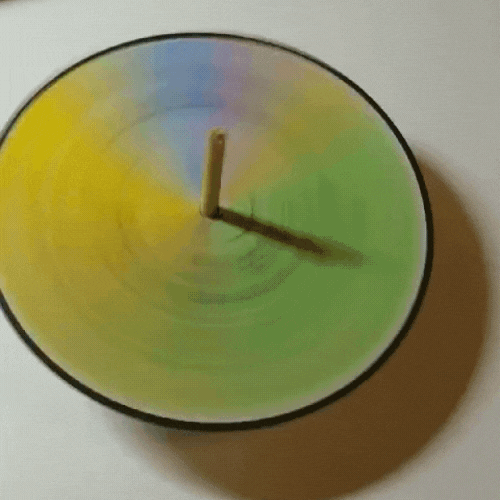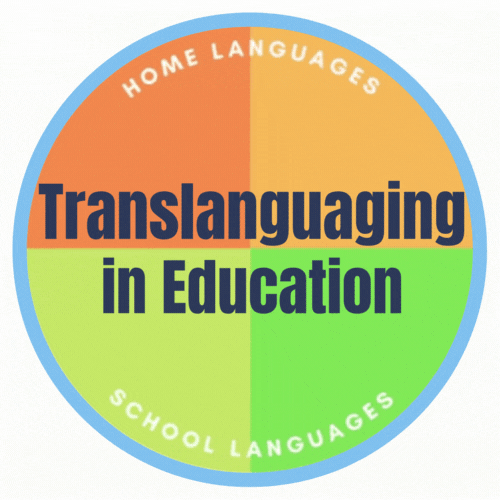Two States of TL Top
Translanguaging(TL) for multilinguals is like a top that a child might play with that has different colours on it to represent different languages as shown in the picture at the bottom left. Such a top is designed for spinning, so it is best appreciated when it spins. When it spins, it shows a mixture of the different colours that are on it. While it spins, we cannot easily determine which colours are combined to show the mixture. We just enjoy the beauty of the mixture of different colours while the top is spinning, feeling as though it is ‘alive’ as illustrated in the figure at the bottom right.
In a similar fashion, multilinguals show their true identity and knowledge when they use all of their language resources freely like a spinning top. They also use only part of their language resources, for example, one language out of several, to communicate appropriately according to the communicative context, which is represented by a static top. However, using one language is marked because they have to suppress the rest of their language resources except for the one that is being used (García, 2009; 2017). Using the top metaphor, TL is using all of their language resources freely across language boundaries as a spinning top and properly according to the communicative context as a static top in order to communicate effectively.
STATIC TOP

-
External perspective: takes the social perspective of the society with two languages
-
Inhibits more than half of bilingual students’ linguistic repertoire
-
Inhibits minimal part of monolingual students’ linguistic repertoire
-
feature suppression
The static top presents multilinguals as having multiple separate languages that do not influence one another. People with this view believe that only a single language should be used depending on the time, place, and people with whom the speaker interacts. According to the static top, the boundaries across the languages are clearly established and kept and a language should not be mixed with other languages that they know.
Many schools around the world have this static top kind of language-in-education policy and practices in their school. They allow only the school language (SL) to be used in school. As a result of this static top-based language-in-education policy, the students whose home language (HL) is different from SL have to inhibit much of their language resources when they learn new content and show their knowledge.
If their SL is just emerging at the low grades of primary school, most of their language resources, consisting mostly of their HL, have to be suppressed (García, 2017) and buried. Their learning process is hindered by their limited knowledge of SL and they can show only a limited part of their knowledge to the extent they are capable of using SL.
Monolingual students whose home language is the same as the SL, on the other hand, can utilize most (if not all) of their language resources and inhibit just a minimal part of their linguistic repertoire such as a non-standard variety of SL. It is therefore no surprise that multilingual students around the world whose HL is non-dominant in society usually lag behind monolingual students whose HL is the dominant language and used as the medium of instruction in school.
This is also true in most primary schools in Northern Thailand. Bilingual students from linguistic minority communities, such as Pwo Karen, Sgaw Karen, Hmong, and Lahu, are not allowed to utilize their HL as a resource in school. They are expected to use only Thai, which is a language they have not developed as well as their HL.
Their academic performance in school is likely to be lower than the students whose HL is Thai. We should not explain their low performance within the student, but from the language-in-education policy and practices that limit their performance. Such language-in-education policy and practices, like static top language use, makes the education playing field sloped. As shown in the video clip below, the static top seems to be standing on the ground, but it is actually lying down on the sloped playing field of education. On this sloped playing field, as symbolized with the slope of the lower triangle, it is easy for dominant HL speakers to easily make progress as in walking downhill as opposed to non-dominant HL speakers who trudge uphill. How then can we make this sloped playing field level? The answer is that we should also allow multilingual students to spin their TL top while most schools already have language practices of static top.
SPINNING TOP

-
Internal perspective: takes the perspective of the TL individual with a single language
-
Deploys their linguistic repertoire fully, naturally, and freely
-
Takes advantage of their full repertoire
-
Inhibitory demands on both mono- and bilinguals: minimal
The spinning top presents multilinguals as having a unitary linguistic repertoire. It deploys their linguistic resources fully, naturally and freely regardless of language boundaries as the top does not show the boundaries of languages when it spins. It encourages students to use all of their language resources at a time.With this spinning top, both monolingual and multilingual students can use most of their language resources for their learning and show what they know.
By adding a spinning top aspect to classroom activities, ethnolinguistic minority students can use most of their linguistic repertoire including their HL practices. In balancing between the static top and the spinning top, we make the playing field of education more equal. It helps both school language speaking monolingual and ethnolinguistic minority multilingual students learn under the same language rules of using most of their linguistic repertoire.
TL pedagogy does not mean having to always spin the top. It needs static top practices such as learning language and content using one language. However, static top practices need to be balanced with spinning top practices by encouraging students to freely use all of their language resources to the extent that it is appropriate and strategic for learning as symbolized in the video clip below. Only then does the education playing field become level for both multilingual and monolingual students.
Who can make the playing field level? Unless someone spins the top, it remains to be static. It is the teacher who can, and it is the teacher who should make the top spin. Unless the teachers are willing to spin the top, nothing will happen except for a static top on the sloped playing field. In order for teachers to spin the top, they must have a positive attitude towards the spinning top. Have a look at the kind of activities we conducted during the workshop to help the teachers transform their stance about student's HL and bilingualism.
STATIC TOP represents

SPINNING TOP represents

-
Language is named
-
Language as a structure
-
Language as a noun
-
Language is socially and politically constructed
-
Language as a discrete entity
-
Looks at language from an external perspective
-
Language specific performance
-
Additive bilingualism
-
Code-switching as marked & deviation
-
Two monolinguals in one person
-
Saussurean idea of language
-
A product of colonialism
-
Like a bicycle
-
Like playing drum with one hand
-
Dynamic bilingualism
-
Emergent bilingual
-
Transcending language boundary
-
Transcending boundary of academic disciplines
-
Disruption of named language
-
General linguistic performance
-
Language is performed
-
Language flows
-
One linguistic system with features
-
Languaging
-
Transforming subjectivities
-
Utilizing one's whole linguistic repertoire
-
Code-switching as norm/unmarked
-
Porous/fuzzy language boundaries
-
Look at speakers from their internal perspective
-
Language shapes and is shaped by the context
-
Like an all-terrain vehicle
-
Like playing a drum with two hands
-
Like a banyan tree
-
Like a pentathlete
Continuum between the two states of TL top
All translanguaging strategies and activities occur along the continuum between the spinning top and the static top. In order to perform well with one language being used in school as visualized with the static top, the students need to be given the chances to freely leverage their whole language resources for their learning as modeled with the spinning top.
Balancing between the two states of language top(s)
for quality and just education for all students
When bilingual students learn and are assessed when using only one language at a time as modeled with the static top, the playing field of education is sloped as they cannot fully show their true knowledge and ability in classroom contents and language. The playing field of education becomes level only when they can leverage their full linguistic repertoire and perform fully in school as modeled with the spinning top, in addition to using languages separately.
